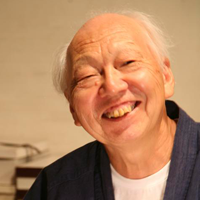
Torao Ishii
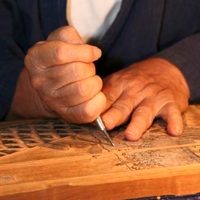
Cherry trees are used for printing blocks for Ukiyo-e.
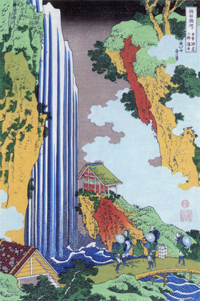
Ishii creates a reproduction of the printing block of Hokusai Katsushika's "Shokoku Taki-meguri."
What is a woodblock print?
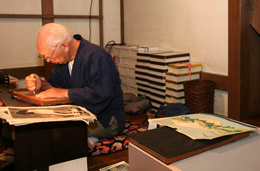
Ukiyo-e
As for Ukiyo-e, since a painter has already died, an engraver should carry out determination of colors. It is completely possible to discern how many colors are used when seeing original pictures. For example, different kinds of black are intentionally used. In this picture, three colors are used for hair.
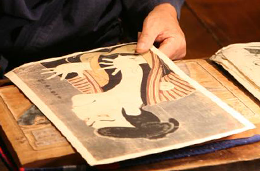
"Senja-fuda," or worshiper's name card
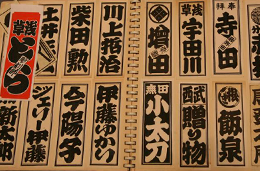
Also, all Senja-fuda stuck on shrines and temples are black and white Senja-fuda. Colored Senja-fuda are made for pleasure. Some Senja-fuda lovers spend one to two hundred thousand yen to print them.
How did Ishii become a woodblock engraver?
What is a woodblock engraver?
Could you tell me why you became a woodblock engraver?
I did not want to be an engraver from the beginning. I did not really like to study, and, if I stayed in my parent's home, I would be forced to be a farmer. I am a second son, so I did not want to be a farmer. Anyway, I had wanted to go to Tokyo. Also, my uncle worked as an engraver in Kamedo (Eto Ward), so in the first place, I stayed at his home and loafed around for several months. When I just saw him working, he said to me, "If you do not have anything to do, why don't you try doing this job." It was the beginning. So it took many years until I became full-fledged.
At around what age did you become full-fledged?
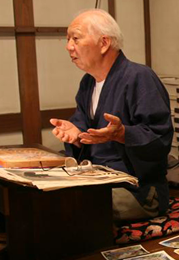
Could you tell me about your work?
My main work is definitely the traditional prints. In the season of New Year's card, I teach how to engrave and print it at some facilities, including museums. Those prints are called "creative prints."
Woodblock Print
Could you teach the traditional method for engraving woodblocks?
First of all, I turn a picture back, and past it on a woodblock. Then, after shaving the picture and making it thin, I engrave the top side of the woodblock. Once all lines are engraved by using a knife, the surrounding part is engraved by using a gouge. I also hammer the gouge. So I need to hold a desk by my feet so that the desk does not move. I use both my hands and feet. Then, I remove unnecessary parts using a flat chisel, and finish it using a chisel. This is the process to engrave a woodblock.
Do engraving methods differ according to types of prints?
It is same. The method and tools are entirely same. Only the names, such as traditional or creative print, are different. So, when you see prints, you cannot discern traditional prints from creative ones. But, as for Ukiyo-e, the difference can be discerned.
How many colors are used for Ukiyo-e?
Generally, all colors are applied on 5 or 6 woodblocks. Printers use up to 30 colors. They apply colors using the gradation method.
How many prints can be printed using a finished printing block?
If 400 or 500 prints are printed at one time because of its salableness, the printing block becomes unusable. Generally, they stop printing when 100 or 200 prints are printed. Then, they dry the printing block for several months, and 100 or 200 prints are printed again. I think a total of several thousand prints can be printed.
Are styles of prints are different in the Kanto and Kansai Region?
As for Ukiyo-e in the Edo Period, colors are exactly determined. For example, when you look at representations of flowers, you can quickly discern whether they are finished in the Kanto or Kansai Region. Prints are more skillfully printed in the Kansai Region. Flowers are softly represented. A way of pressing "Baren," or disk-shaped pad, is different. It makes the difference. As far as Ukiyo-e is concerned, there is less difference in engraving techniques than in printing techniques. The techniques differ greatly between different masters. There are about 10 fellow woodblock engravers, but when we meet together and talk about engraving techniques, it turns out that our techniques differ according to our masters. Tools and ways of engraving are little bit different among us. Ways of sharpening chisels also differs.
Are names of engravers and printers written on finished prints?
Their names are rarely written on prints because engravers and printers are craftsmen. Painters names are written on prints because painters are artists. But there are one or two Ukiyo-e prints on which Hiroshige Utagawa's name, a famous Ukiyo-e artist, is written. Perhaps, Utagawa gained the favor of a painter, or the prints were studies, so his name was written on them. Also, publishers' names are not written on prints. In some cases, names of engravers and printers are written here (their names are usually written on the outside of picture). When "Edo Hyakkei" was reissued for the first time, names of all people - a painter, engraver, printer and publisher - were written.
Tools
Could you tell me about tools that you are using?
The tool I am now using is an engraving knife. It is also called "knife." About 70% of engraving work can be done with this tool. All lines can be engraved by this. The remaining 30 to 40% can be finished by chisels. There are not so many tools. I use 3 gouges and 2 flat chisels. There is no other chisel. In addition, there are one knife and 7 or 8 "Sarai Nomi," or cleaning knives.
Do you make these tools by yourself?
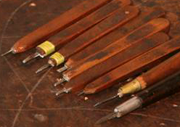
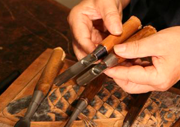
Have you used the flask for lighting for a long time?
I have used it since my apprentice days. Some engravers use electric lamps. Electric lamps radiate heat. But if light goes through a flask, it is not hot at all. I use writing brushes. When I write, brushes do not dry up. In addition, when I use the flask, shadows of hands are not made even if I use a knife in any direction. On that point, it is useful. So nowadays, I guess all engravers use it. But printers just hang unshaded light bulbs, and do not use a flask.
Traditional Division of Labor
The division of labor has changed since the Edo Period?
It has not changed at all. A publisher takes an original picture to an engraver. After I finish engraving, I pass the engraved woodblock and the picture to a printer. The printer looks at the picture, applies colors on the woodblock and prints it. Then, he returns the prints and picture to the publisher. Finished prints are sold and bought by publishers.
In the present, how many publishers are there?
There are 5 or 6 publishers in Tokyo. There are not so many major publishers. Publishers also exists in the Kasai Region. When my master was active, there might be more publishers. The number of engravers have also decreased. At that time, there were 20 to 30 engravers. Now, there are less than 10 engravers. Yes. There are about 10 engravers. I think there are an equal number of engravers in the Kansai Region.
When I want to make Senja-fuda, how can I order?
First of all, you should consult with a printer. In general, major publishers do not handle it. After you consult with a printer and determine its design, you should visit an engraver. If you want to make black and white Senja-fuda, you may directly ask an engraver to engrave it.

Torao Ishii

Cherry trees are used for printing blocks for Ukiyo-e.

Ishii creates a reproduction of the printing block of Hokusai Katsushika's "Shokoku Taki-meguri."
What is a woodblock print?

Woodblock prints are pictures that are printed using woodblocks. Woodblock prints were rapidly developed along with the emergence of Ukiyo-e in the Edo Period. The division of labor consisting of painters, engravers and printers was also established in that period.
Ukiyo-e
As for Ukiyo-e, since a painter has already died, an engraver should carry out determination of colors. It is completely possible to discern how many colors are used when seeing original pictures. For example, different kinds of black are intentionally used. In this picture, three colors are used for hair.

It is possible to use the same woodblock to print different colors, which are painted on distant parts of a picture. So, approximately 30 colors can be applied on 5 or 6 woodblocks. At least 30 colors are used in "Edi Hyakkei," or one hundred view of Edo.
"Senja-fuda," or worshiper's name card

Since Senja-fuda is a talisman, people visit shrines and temples, and stick it on invisible places, such as the back of temple gates. It is stuck with seaweed glue, so no mark is left when it is peeled off. But nowadays stickers are widespread. Since, if stickers are used, it is difficult to remove adhesive, so use of stickers is banned.
Also, all Senja-fuda stuck on shrines and temples are black and white Senja-fuda. Colored Senja-fuda are made for pleasure. Some Senja-fuda lovers spend one to two hundred thousand yen to print them.






